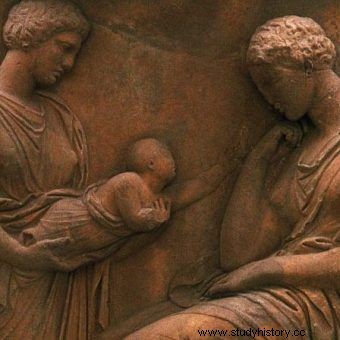ion id ="attachment_83431" align ="alignright" width ="340"] Many ancient medical practices have survived in Western medicine for centuries. Fortunately, tearing out children with a hook was not a common activity later ... In the illustration, a fragment of an ancient relief. [/ Caption]
Ancient authors have preserved information about such extraordinary events as the birth of quintuplets - it is known that an Egyptian woman managed to do so. She thus pierced the ruler of Egypt Cleopatra VII, one of the most famous women of antiquity, who gave birth to "only" twins.

Many of the medical practices of antiquity have survived in Western medicine for centuries. Fortunately, tearing out children with a hook was not a common activity later ... In the illustration, a fragment of an ancient relief.
It is difficult to imagine how women in ancient times could bear such multiple pregnancies and give birth to numerous offspring. Contact with male doctors was difficult, so those - for safety - from the times of Hippocrates, swore that they would not sexually abuse the treated people. Not without reason.
The legendary Agnodike, the first female doctor in Athens from the 4th century BC. (about which you can read more HERE), was accused by competitors of ... seducing patients . She almost paid for it with banishment, and even with her life. Fortunately, the Athenians themselves stood up for her, rebelled against "phallocracy" and won women the right to explore the secrets of the organs with which they give birth to children.

Agnodike, rumored to be the first female doctor in ancient Athens, is not generally considered a historical figure. Nevertheless, her story, told by the Roman writer Gaius Julius Hyginus, was often used as an argument by women practicing obstetrics.
Doctor with a hook
Childbirth in antiquity was, from our modern point of view, an almost extreme experience. No anesthesia, no doctors, no modern medical instruments. But with a primitive birthing chair and magical artifacts from animal organs, which further increased the lethal risk of infection ...
There was also an emergency exit in the form of caesarean section - practiced by the Romans on the bodies of women who did not manage to endure the hardships of childbirth. The baby was taken out of the womb of the dead mother and at times it managed to survive. Contrary to the name and associations, Julius Caesar was not born in this way. According to historians, however, another famous Roman was born by the "Emperor" - Publius Cornelius Scipio, the vanquisher of Hannibal.

This article was written during the author's work on the book "Ages of shamelessness. Sex and erotica in antiquity ”(CiekawostkiHistoryczne.pl 2018).
When the delivery did not go according to the recipients' plans and attempts were made to save the mother, the child could be pulled out using drastic methods:using a hook, even by an eye socket. Mary Beard, historian of the daily life of ancient Rome, writes:
If the baby was completely stuck, some Roman doctors recommended inserting a knife into the mother's body and dismembering the fetus in the uterus - a procedure that only a few women may have endured without any health damage .
The researcher emphasizes that pregnancies and childbirths were critical events in the lives of women, so willingly portrayed as carefree libertines. “Childbirth is dangerous today, but in Roman times it was a battlefield. Men died in the war, women died in childbearing, "Beard states.
Dumpster for imperfect children
The babies born in such conditions, after many hardships, were not safe at all. A Roman midwife, if she saw that a newborn had some congenital abnormality, she might have intentionally failed to tie or cut the umbilical cord too close, leading to the bleeding out and death of the baby . Those toddlers who survived could not always count on care. There were also unwanted children among them. More often girls than boys (because they did not require dowry in the future ...).

Many children born in antiquity ended up abandoned, often in the garbage can. Only luck depended on whether any of the unwanted babies would survive ... Pictured is a marble plaque depicting a woman giving birth, found in Ostia, an ancient port city of ancient Rome.
Such babies were simply abandoned. They were treated as an object as unnecessary. Athenians, Corinthians and Romans did not even enjoy such a celebration as in the notorious Sparta, where "imperfect" children were abandoned in the mountains of Tajget. They just left the little ones by the roads, in the woods, in an earthen pot, in a garbage can. There were times when someone merciful found them and treated them like their own children. But sometimes they fell into the hands of the greedy and soulless, who raised the "find" into a cheap slave girl, destined for prostitution for her owner .
It happened that some of these "find" got to know their origin over time. Such a thread appeared in the ancients in myths (for example, Oedipus), dramas and comedies. Maybe it had a therapeutic purpose, reducing the parents' remorse? Well, instead of throwing out an unwanted baby, you could just take care not to bring him into the world. However, effective contraception is not only a problem of the ancients….
*** The text was created during the author's work on his latest book entitled " Ages of shame. Sex and erotica in antiquity ” .
Bibliography:
- Mary Beard, SPQR. History of Ancient Rome , crowd. Norbert Radomski, Rebis, 2016.
- Peter Connolly, Hazel Dodge, Ancient cities:architectural wonders, social, cultural and religious life , crowd. Barbara Tkaczow, RTW, 1998.
- Diane Ducret, Forbidden Body , crowd. Anna Maria Nowak, Znak, 2016.
- Meet the Romans with Mary Beard , episode 3:Behind Closed Doors, BBC, 2012.
- Joyce E. Salisbury, Encyclopedia of Women in the Ancient World , ABC-CLIO, 2001.
- Lidia Winniczuk, People, customs and customs of ancient Greece and Rome , State Scientific Publishers, 1983.
